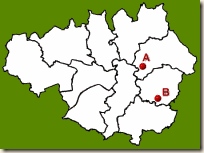You often hear ADIs going on about only teaching people the bare minimum of skills required to pass the driving test instead of teaching them how to drive properly. The DSA’s strapline is “Safe Driving for Life”. So it beggars belief when you see a story like this.
 On the surface, it’s just another FOI request blown out of proportion by some local hacks. But the really frightening part is the case studies they’ve dug up.
On the surface, it’s just another FOI request blown out of proportion by some local hacks. But the really frightening part is the case studies they’ve dug up.
The article reports that Failsworth test centre has the lowest pass rate in Manchester, at 39.2% (bolstered by a really funny (not) reference to the name). It points out that Hyde test centre is 16% higher than this, at about 55%. As I mentioned recently, no one is ever prepared to refer to the population demographics in the areas they are comparing. Failsworth (marked as “A” on the map), being much closer to the centre of Manchester (and virtually part of Oldham), has a much higher proportion of non-UK national citizens. Hyde (marked as “B”) is out in the sticks, even though it is still part of Greater Manchester. Indeed, it is only about 6 miles from Glossop – which is so rural not everyone has electricity there yet! The article also says that Buxton – 25 miles out into the countryside – has a pass rate of 61.4%. Obviously, higher pass rates are the story editors’ only focus – but it does illustrate my point.
But here’s the best part. They give several examples. Firstly, someone called Kate Emmott failed at Failsworth, and is now planning on taking her test at an “easier” test centre. She says that she got a “major” fault (marked as “serious” on the test sheet) for not driving in a bus lane. She says:
It was coming up to 10am and I was worried about it. I think I had a really strict tester to be honest.
If Manchester’s bus lanes are anything like the ones around here, their morning hours of operation are 7.30-9.30. Being “nearly” 10am is not the same as 9.30am, and failing to realise this is not the result of a “strict” examiner. It’s the result of being a bad driver.
Then there is the case of Emily Bleackley, who failed her test four times in Failsworth, and then passed “weeks later” in Hyde. The report says:
…her second fail last December was for ‘getting lost’, while her third attempt was scuppered when she slowed down to let a car pass. Her fourth attempt was down to bad ‘filtering’ with other traffic, she says.
So here’s someone else who cannot equate bad driving with failing your test. You don’t fail for “getting lost” – unless you get lost and then make bad mistakes. Slowing down to let people pass – probably on a busy road, since we’re talking almost the centre of Manchester – is dangerous and the sign of a frightened rabbit! And “bad filtering” almost certainly means not being aware of what others are doing, and changing lanes without proper safety checks. In spite of this, Ms Bleackley says:
…[my] instructor could not understand [my] fails either… She said she couldn’t believe I’d failed because my driving was completely up to standard. I was in tears after my tests at Failsworth.
I’m sorry, Emily, but you listed at least three good reasons why your fails were totally justified, and it is shocking that your instructor thought you were “up to standard” if you were so obviously unable to cope with other traffic. You weren’t up to standard – that’s why you failed, and for reasons which are absolutely clear. And it is worrying that you subsequently passed at a test centre where you’re shortcomings perhaps weren’t challenged. Are you going to drive exactly the way you did on those failed tests now you’ve got your licence? Like not driving in bus lanes, slowing to a crawl when you get scared, and weaving from lane to lane without checking first?
The DSA is quoted as saying:
Pass rates can be influenced by various factors. Some people may take more lessons and be better prepared for the test. Statistical factors can also play a part as the number of tests conducted at different test centres varies significantly.
However, every driving test is conducted to the same strict requirements. We train examiners to a high standard and closely monitor their work to ensure that all tests are assessed consistently across the country.
But nothing can hide the fact that some test centres – and their routes – are inevitably going to be easier, and this is always going to result in some people passing their tests when they have underlying issues with their driving. Although it isn’t the DSA’s fault, the two examples above provide clear evidence that two very substandard new drivers have been put on the roads by the system – and it is therefore the system which is at fault. Unfortunately, the system is too complex to be able to reliably identify every single variable involved, and it is left to people like Ms Bleackley and her driving instructor to open their mouths and provide the necessary pointers to where some of the faults with it might lie.
Another news story adds weight to this, and I’ll put an article about that together shortly.